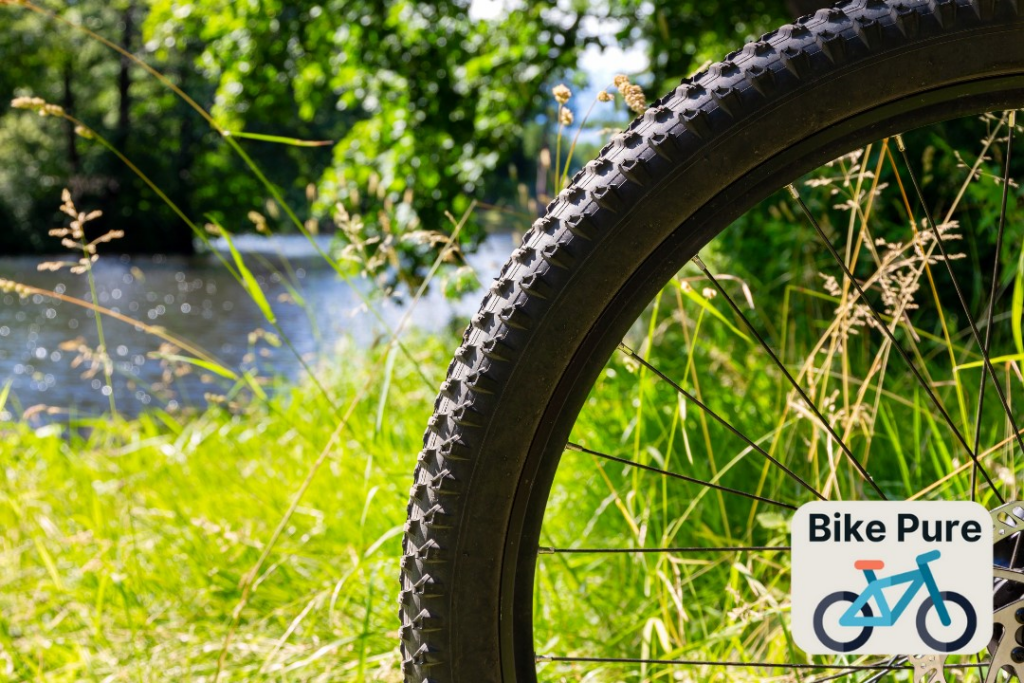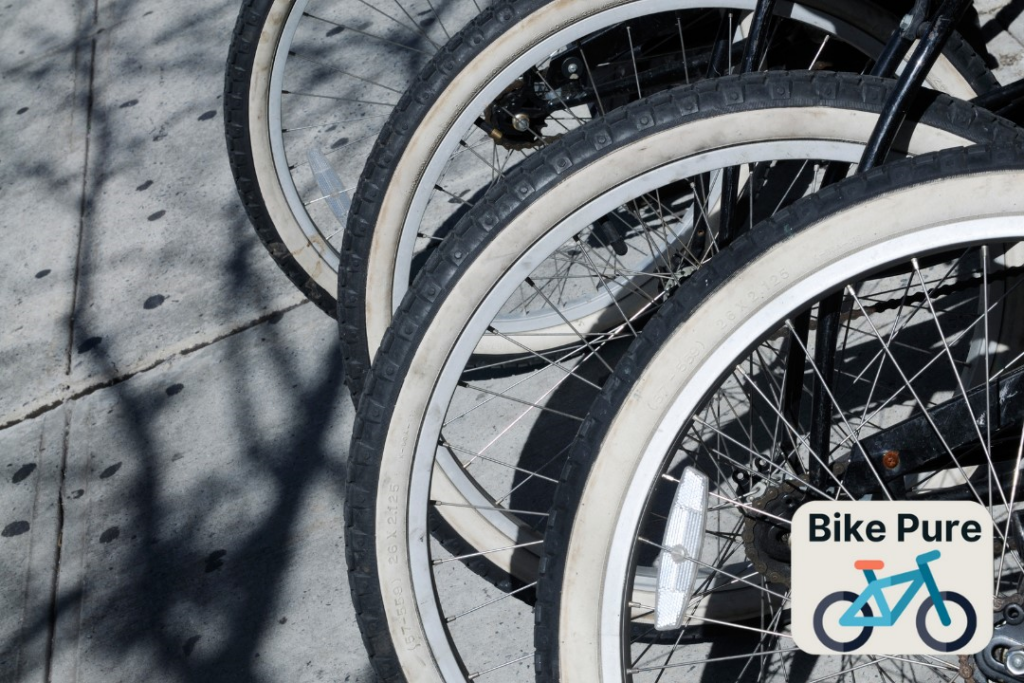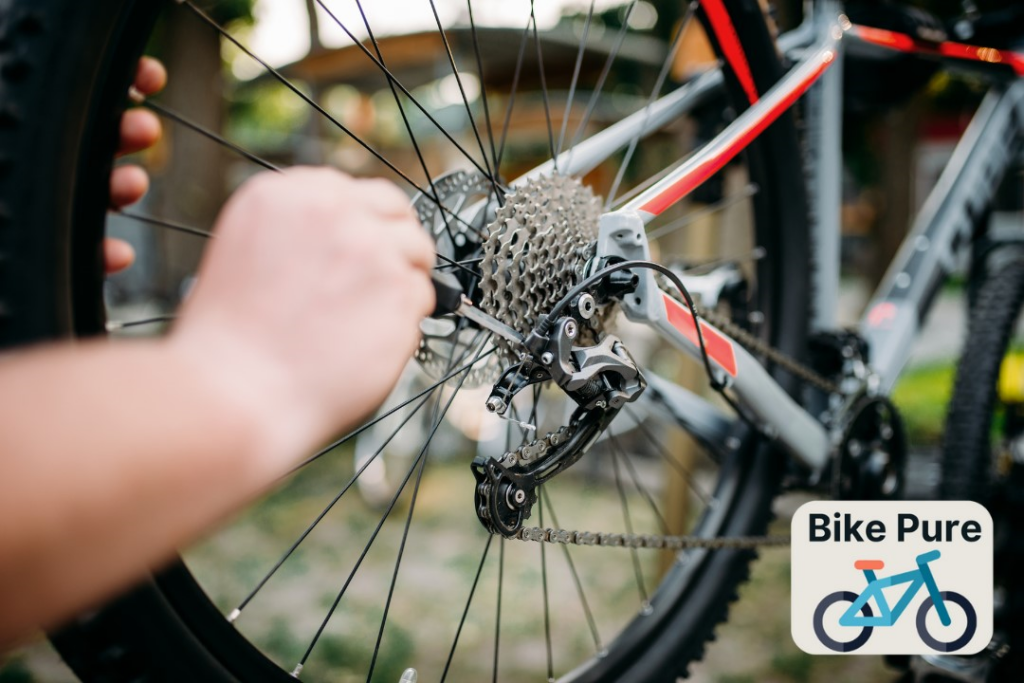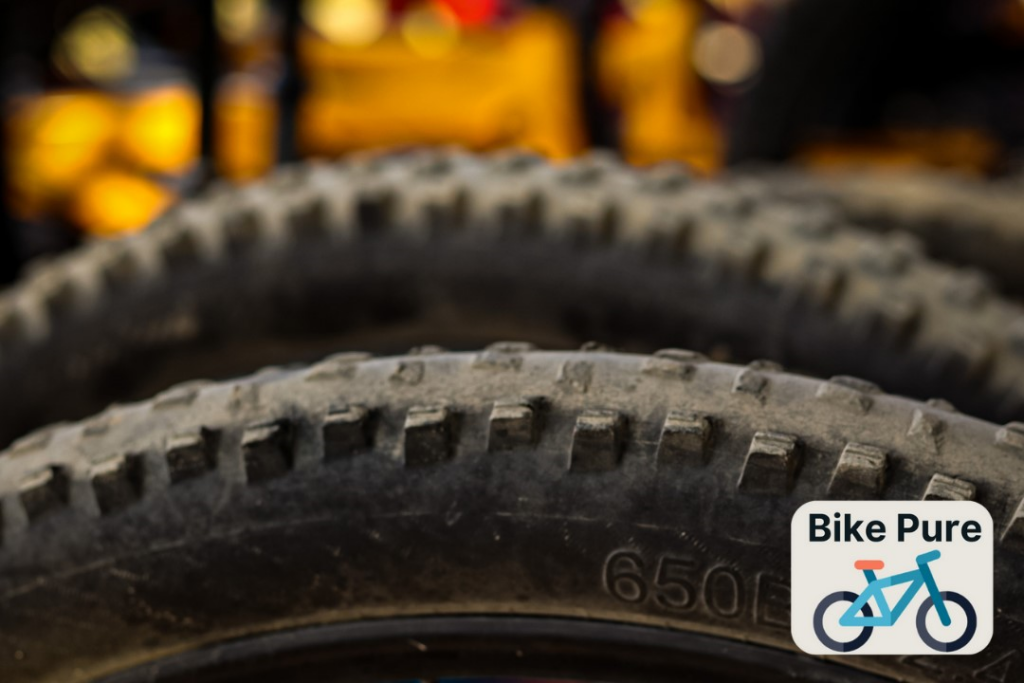Gravel bike tires are designed for cyclists who want to explore off-road terrain while still enjoying the efficiency of a road bike.
These tires are made to offer traction on a variety of surfaces, from rough dirt paths to loose gravel roads. The versatility of gravel bike tires makes them a popular choice for adventure-seeking cyclists and those looking to expand their riding horizons.
When shopping for gravel bike tires, it’s important to understand the key factors to consider, such as tire width, diameter, materials, and construction.
The right tire can enhance your riding experience, while the wrong one can detract from it. Maintaining and caring for your tires can extend their lifespan and ensure optimal performance.
Key Takeaways
- Gravel bike tires provide traction on a variety of surfaces, offering versatility for off-road riding
- Factors to consider when choosing tires include width, diameter, materials, and construction
- Proper maintenance and care can extend the lifespan and improve the performance of your tires
Anatomy of a Gravel Bike Tire
1. Tread Pattern: The Main Contact Point with the Ground

The tread pattern is important for the performance of a gravel bike tire. In general, it is designed to provide a balance between grip and rolling resistance on various terrains, including loose gravel, packed dirt, and pavement.
The tread pattern may feature small, closely-spaced knobs for a smoother ride on hard surfaces or larger, widely-spaced lugs for better traction on soft and loose terrain.
Remember, when selecting a gravel tire, consider the tread pattern that will best suit the types of terrain you most frequently encounter.
2. Sidewall: Protecting the Tire’s Profile
The sidewall of a gravel bike tire plays a big role in protecting the tire’s overall structure. It ensures that the tire maintains its shape and provides reliable support for the casing.
Usually, a more robust sidewall includes added layers of rubber or puncture-resistant materials for extra durability and strength. This added protection is essential for off-road riding, where sharp rocks or debris could potentially cause cuts and tears.
3. Bead: Ensuring a Snug Fit with the Rim
The bead is the part of the tire that keeps it secured to the rim. It consists of a strong, stiff band (commonly made of steel or Kevlar) that sits within the tire’s casing. The bead ensures a snug fit when the tire is inflated, preventing it from slipping off during use.
A tight bead-to-rim connection is especially significant for gravel riding due to the various terrain demands and the risk of a bead failure causing a sudden deflation and loss of control.
4. Casing: The Tire’s Main Body
The casing is the primary body of the tire and serves as the skeleton that supports the tread and sidewall. The main component of the casing is the fabric weave, which is typically made from materials like nylon, polyester, or cotton. The weave’s tightness, or Threads Per Inch (TPI), affects the tire’s overall ride characteristics.
A higher TPI signifies a lighter and more supple tire with a lower rolling resistance, while a lower TPI means a more sturdy and durable tire that can withstand rougher gravel conditions. The casing is essential in determining a tire’s overall performance, weight, and puncture resistance.
Types of Gravel Bike Tires

When it comes to gravel biking, choosing the right type of tire is consequential for optimum performance and comfort. This guide will cover the three main types of gravel bike tires: Clincher, Tubeless, and Tubular. Each type comes with its unique benefits, features, and considerations.
| Tire Type | Description |
|---|---|
| Clincher | Traditional bike tires with an outer casing and a separate inner tube. Easy to repair and widely available. Provides air, supports the tire structure, and offers a comfortable ride. Comes in various sizes and tread patterns. Suitable for gravel roads. |
| Tubeless | Modern tires without inner tubes. Relies on a tight seal between tire and rim. Can run at lower pressure without risk of pinch flats. Liquid sealant fills and closes minor punctures. Offers improved traction and reduced chances of flat tires. Suitable for long gravel rides. |
| Tubular | Less common in gravel biking. Consists of an outer casing with a non-removable inner tube. Entire structure is glued to the rim. Provides seamless connection between tire and wheel. Time-consuming to glue and challenging to replace when punctured. Offers great traction and a unique ride experience. Limited application in gravel biking. |
Clincher: Traditional Tires with Tubes
Clincher tires are the most common and traditional type of bike tire. They consist of an outer tire casing with a separate inner tube. The inner tube is responsible for providing air, supporting the tire structure, and ensuring a comfortable ride.
A major advantage of clincher tires is their ease of repair and availability. If a clincher tire gets a puncture, riders can simply replace the inner tube and continue their journey. These tires also come in various sizes and tread patterns, offering plenty of options for riders to find suitable traction on gravel roads.
Tubeless: Modern Approach Without Inner Tubes
Tubeless tires have become increasingly popular in recent years, thanks to their ability to run at lower pressure without risking pinch flats. They function without an inner tube, relying on a tight seal between the tire and rim. When combined with a liquid sealant, tubeless tires are more resistant to small punctures, as the sealant automatically fills and closes minor holes.
One of the main benefits of tubeless tires is their improved traction, allowing riders to navigate rough gravel surfaces more effectively. The tubeless design also reduces the chances of getting a flat tire, making it a reliable option for long gravel rides.
Tubular: Tires Glued to the Rim
Tubular tires are less common in the gravel biking scene, but they still have a dedicated following. These tires consist of an outer casing with an integrated, non-removable inner tube. The entire structure is glued to the rim, providing a seamless connection between the tire and wheel.
While tubular tires are known for their excellent performance on road bikes, their application in gravel biking is more limited. The process of gluing the tire to the rim can be time-consuming, and replacing a punctured tire can be challenging during a ride. However, some riders still prefer the feeling of tubular tires on gravel, as they offer great traction and a unique ride quality.
Each type of gravel bike tire offers its benefits and trade-offs. Clincher tires provide ease of use, while tubeless tires give better traction and puncture resistance. Tubular tires, while less common, offer a distinct ride experience. Make sure to consider your riding preferences and the terrain you typically encounter before making your final decision on the right gravel bike tire.

Tire Width and Diameter
Common Sizes for Gravel Bikes
Gravel bike tires come in a variety of widths and diameters to suit different riding styles and terrains.
Common tire widths for gravel bikes range from 32 mm up to around 50 mm.
The most popular diameters include 700c, also known as the standard road bike wheel size, and 650b, which offers a slightly smaller and wider option.
| Tire Width | Pros | Cons |
| Narrower (<35mm) | Less rolling resistance, lighter | Less grip, less comfortable on rough terrain |
| Wider (>35mm) | Better grip, more comfortable | Increased rolling resistance, heavier |
Pros of Wider Tires: Better Grip, More Comfort
Wider tires offer several advantages over their narrower counterparts. They provide better grip on various surfaces, such as loose gravel, mud, and sand, due to their larger contact area with the ground. This increased grip helps riders feel more stable and secure when navigating off-road terrain.
Another advantage of wider tires is the increased level of comfort they provide. The higher volume of air contained in a wider tire allows for more significant shock absorption when riding over rough surfaces. As a result, riders experience a smoother, less jarring ride.
Cons of Wider Tires: Potential for Drag, Weight
Despite the advantages of wider tires, they also come with a few drawbacks. One of these is the potential for increased rolling resistance on certain terrains, particularly on smooth surfaces like asphalt. Greater tire width can increase the surface area and create more drag, which can slow riders down compared to those using narrower tires.
The added weight of wider tires can have an impact on performance. A heavier tire can make accelerating more laborious, and riders may tire more quickly, especially on uphill climbs. In competitive situations, this extra weight could mean the difference between victory and defeat.
The width and diameter of gravel bike tires play a big role in the overall riding experience. Rider preferences, individual riding styles, and the specific terrain being ridden should all factor into the decision-making process when selecting the appropriate tire size.
Materials and Construction
Rubber Compounds: Soft Vs. Hard Rubber
Gravel bike tires have varying rubber compounds that come in soft and hard rubber forms. Soft rubber provides better grip and traction on different terrains, which is essential for gravel cycling. However, they wear down more quickly than hard rubber compounds.
Hard rubber, on the other hand, offers increased durability and longer tire life but may have less grip on some surfaces. Therefore, it is important to strike a balance between grip and longevity when selecting a tire rubber compound.
Puncture Protection Layers: Shielding Against Sharp Objects
One important aspect of gravel bike tires is their puncture protection layers that shield the tire from sharp objects such as rocks, glass, and thorns. These layers come in various materials, such as Kevlar or other synthetic fabrics, that increase tire resistance against punctures. Tires with better puncture protection tend to be more durable, ensuring safe rides and reducing the risk of getting stranded due to a flat tire, especially when cycling on unpredictable gravel surfaces.
Casing Materials and Tpi (Threads per Inch): Durability and Flexibility
The casing of a gravel bike tire plays an important role in determining its durability, suppleness, and ride quality. Casing materials vary, with some tires using polyester, nylon, or other synthetic fabrics. The casing’s TPI (threads per inch) is another essential factor that affects tire performance.
A high TPI count indicates finer threads which create a more supple and flexible tire, resulting in better road contact and improved grip. Lower TPI typically results in a stiffer, more durable tire, but it may sacrifice some ride comfort. When choosing a gravel bike tire, consider the balance between durability and flexibility that best suits your riding style and local terrain.
Maintenance and Care

Checking for Wear and Tear: Signs to Look Out for
Gravel bike tires are designed for challenging rides, but their durability doesn’t exclude regular maintenance. Keep an eye on the tire’s condition, checking for cuts, punctures, and any signs of wear in the tread. If the rubber starts to look worn, it’s time to consider a replacement.
Check for any damage to the sidewalls of your tires, as cracks or tears may compromise their performance.
Proper Cleaning: Keeping Tires in Optimal Condition
Clean tires not only look better, but they also have a longer lifespan. After your ride, use a soft brush and soapy water to clean the tires, removing any mud, gravel, or debris that might damage the rubber. Don’t forget to clean the rim and surrounding components to maintain your bike’s overall condition.
Instructions
- Rinse tires with water to remove loose dirt
- Fill a bucket with soapy water
- Use a soft brush, to scrub the tires thoroughly
- Rinse the tires with water again to remove soap
- Allow the tires to air-dry
Storage: Protecting Tires From Adverse Conditions
Storing your gravel bike and its tires in the right conditions is important for maintaining their performance. Keep the bike in a dry and cool area, away from direct sunlight or temperature fluctuations. Storing tires with too much air pressure can cause damage, so it’s best to inflate them to about 50% of their normal pressure during storage.
Storage Tips:
- Use a bike stand or wall mount to keep the tires off the ground
- Avoid placing heavy objects on top of the tires
- Rotate your tires regularly for even wear
When and Why to Replace Tires
Though gravel bike tires are built for durability, they still wear out eventually. Factors such as tread wear, punctures, or sidewall damage may signal a need for replacement. Tire wear can affect ride quality and safety, so it’s imperative to replace tires in a timely manner.
It’s a good idea to keep track of your mileage and replace your tires according to the manufacturer’s recommendations. Generally, tires should be replaced every 2,000 to 3,000 miles, but this can vary depending on individual riding habits, tire construction, and terrain.
Frequently Asked Questions
What size gravel bike tires should I use?
The size of gravel bike tires you should use depends on your riding style, terrain, and personal preference. Generally, riders choose tires ranging from 35mm to 45mm in width. Wider tires provide more comfort and traction, while narrower tires offer less rolling resistance for faster speeds. Experiment with different sizes to find the perfect balance for your needs.
How do I choose the right tread pattern for my gravel tires?
The right tread pattern for your gravel tires depends on the terrain you’ll encounter. The design of tire patterns plays a big role in the noise generated during their operation, with optimal misalignment in tread patterns leading to significant noise reduction, as explored in the study on the effect of tire pattern design on noise.
For smooth, hard-packed gravel roads, shallower treads with smaller knobs work best. For loose or muddy conditions, opt for aggressive treads with larger knobs to improve grip. Mixed-terrain riders can choose an all-around tread pattern that combines aspects of both shallow and aggressive designs.
Which brands offer the best gravel bike tires?
There are several brands that offer excellent gravel bike tires, including Schwalbe, WTB, Panaracer, and Maxxis. When choosing a brand, consider factors such as performance, durability, and price. Read reviews and consult local bike shops to get an idea of what works best for your region and riding conditions.
Are wider tires better for gravel cycling?
Wider tires offer several advantages for gravel cycling, such as increased comfort, better traction, and improved puncture protection. They can handle lower tire pressures, which can help to minimize vibrations from rough surfaces. However, wider tires may also have more rolling resistance, potentially affecting speed.
Determine if the benefits of wider tires outweigh the potential drawbacks based on your intended terrain and riding goals.
What are the differences between 650b and 700c tires for gravel bikes?

The main difference between 650b and 700c tires for gravel bikes is their diameter. 650b tires, also known as 27.5-inch tires, have a smaller diameter, resulting in a lower overall wheel size. This can improve ride quality by offering better traction and agility on technical terrain. On the other hand, 700c tires, also called 29-inch tires, have a larger diameter, providing a faster rolling speed and better efficiency on smoother surfaces.
How do I determine the ideal tire pressure for gravel cycling?
Determining the ideal tire pressure for gravel cycling depends on factors such as tire width, rider weight, and terrain. Generally, wider tires accept lower pressures, which help provide more traction and comfort on rough surfaces.
Begin by following the manufacturer’s recommended pressure range printed on the tire sidewall, then adjust based on your riding conditions and personal preferences. Experiment with different pressures to find the sweet spot between comfort, traction, and efficiency.













